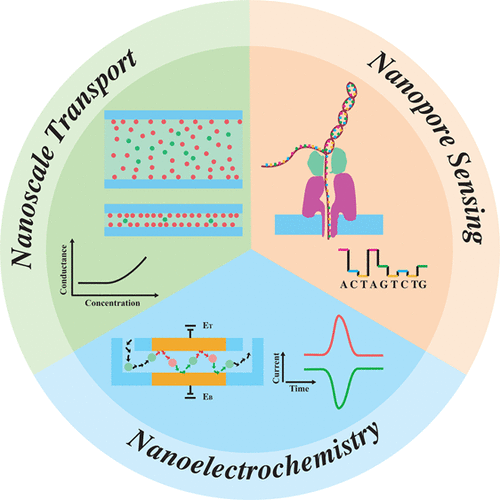当前位置:
X-MOL 学术
›
ACS Cent. Sci.
›
论文详情
Our official English website, www.x-mol.net, welcomes your
feedback! (Note: you will need to create a separate account there.)
Nanopore Electrochemistry: A Nexus for Molecular Control of Electron Transfer Reactions
ACS Central Science ( IF 12.7 ) Pub Date : 2018-01-16 00:00:00 , DOI: 10.1021/acscentsci.7b00576 Kaiyu Fu 1 , Paul W. Bohn 1
ACS Central Science ( IF 12.7 ) Pub Date : 2018-01-16 00:00:00 , DOI: 10.1021/acscentsci.7b00576 Kaiyu Fu 1 , Paul W. Bohn 1
Affiliation

|
Pore-based structures occur widely in living organisms. Ion channels embedded in cell membranes, for example, provide pathways, where electron and proton transfer are coupled to the exchange of vital molecules. Learning from mother nature, a recent surge in activity has focused on artificial nanopore architectures to effect electrochemical transformations not accessible in larger structures. Here, we highlight these exciting advances. Starting with a brief overview of nanopore electrodes, including the early history and development of nanopore sensing based on nanopore-confined electrochemistry, we address the core concepts and special characteristics of nanopores in electron transfer. We describe nanopore-based electrochemical sensing and processing, discuss performance limits and challenges, and conclude with an outlook for next-generation nanopore electrode sensing platforms and the opportunities they present.
中文翻译:

纳米孔电化学:电子转移反应分子控制的纽带。
基于孔的结构广泛存在于活生物体中。嵌入细胞膜的离子通道,例如,提供了电子和质子转移与生命分子交换耦合的途径。从大自然中吸取教训,最近的活动激增集中在人造纳米孔结构上,以实现大型结构中无法实现的电化学转化。在这里,我们重点介绍这些令人振奋的进步。从对纳米孔电极的简要概述开始,包括基于纳米孔受限电化学的纳米孔传感的早期历史和发展,我们介绍了纳米孔在电子转移中的核心概念和特殊特征。我们描述了基于纳米孔的电化学传感和处理,讨论了性能极限和挑战,
更新日期:2018-01-16
中文翻译:

纳米孔电化学:电子转移反应分子控制的纽带。
基于孔的结构广泛存在于活生物体中。嵌入细胞膜的离子通道,例如,提供了电子和质子转移与生命分子交换耦合的途径。从大自然中吸取教训,最近的活动激增集中在人造纳米孔结构上,以实现大型结构中无法实现的电化学转化。在这里,我们重点介绍这些令人振奋的进步。从对纳米孔电极的简要概述开始,包括基于纳米孔受限电化学的纳米孔传感的早期历史和发展,我们介绍了纳米孔在电子转移中的核心概念和特殊特征。我们描述了基于纳米孔的电化学传感和处理,讨论了性能极限和挑战,










































 京公网安备 11010802027423号
京公网安备 11010802027423号